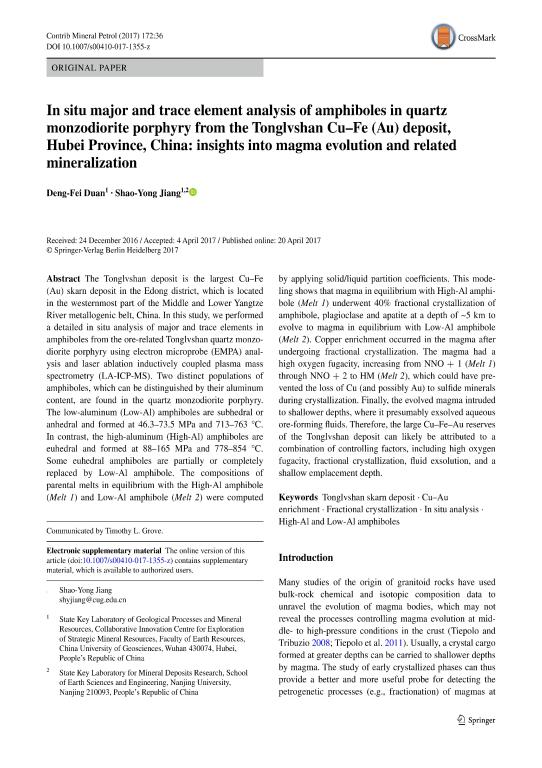

Deng Fei Duan1, In situ major and trace element analysis of amphiboles in quartz monzodiorite porphyry from the Tonglvshan Cu–Fe (Au) deposit, Hubei Province, China: insights into magma evolution and related mineralization
The Tonglvshan deposit is the largest Cu–Fe (Au) skarn deposit in the Edong district, which is located in the westernmost part of the Middle and Lower Yangtze River metallogenic belt, China. In this study, we performed a detailed in situ analysis of major and trace elements in amphiboles from the ore-related Tonglvshan quartz monzodiorite porphyry using electron microprobe (EMPA) analysis and laser ablation inductively coupled plasma mass spectrometry (LA-ICP-MS). Two distinct populations of amphiboles, which can be distinguished by their aluminum content, are found in the quartz monzodiorite porphyry. The low-aluminum (Low-Al) amphiboles are subhedral or anhedral and formed at 46.3–73.5 MPa and 713–763 ℃. In contrast, the high-aluminum (High-Al) amphiboles are euhedral and formed at 88–165 MPa and 778–854 ℃. Some euhedral amphiboles are partially or completely replaced by Low-Al amphibole. The compositions of parental melts in equilibrium with the High-Al amphibole (Melt 1) and Low-Al amphibole (Melt 2) were computed by applying solid/liquid partition coeffcients. This modeling shows that magma in equilibrium with High-Al amphibole (Melt 1) underwent 40% fractional crystallization of amphibole, plagioclase and apatite at a depth of ~5 km to evolve to magma in equilibrium with Low-Al amphibole (Melt 2). Copper enrichment occurred in the magma after undergoing fractional crystallization. The magma had a high oxygen fugacity, increasing from NNO + 1 (Melt 1) through NNO + 2 to HM (Melt 2), which could have prevented the loss of Cu (and possibly Au) to sulfde minerals during crystallization. Finally, the evolved magma intruded to shallower depths, where it presumably exsolved aqueous ore-forming fuids. Therefore, the large Cu–Fe–Au reserves of the Tonglvshan deposit can likely be attributed to a combination of controlling factors, including high oxygen fugacity, fractional crystallization, fuid exsolution, and a shallow emplacement depth.
